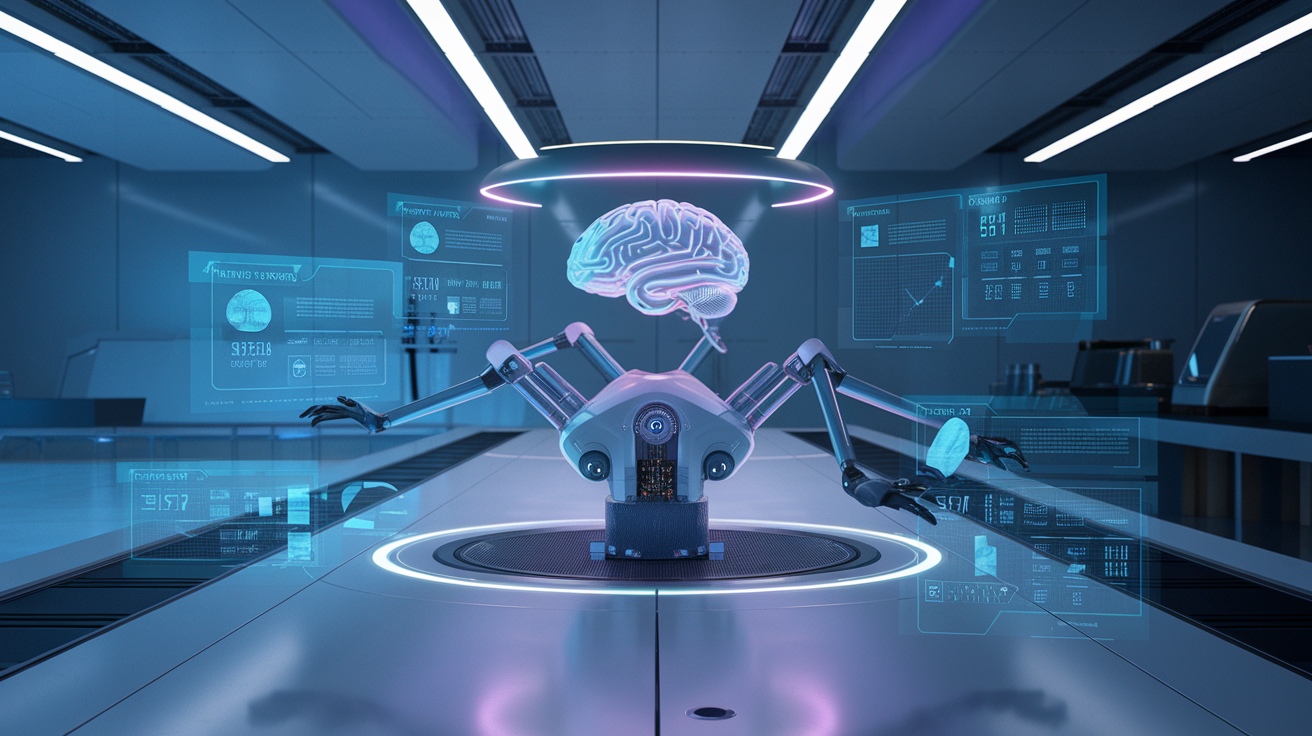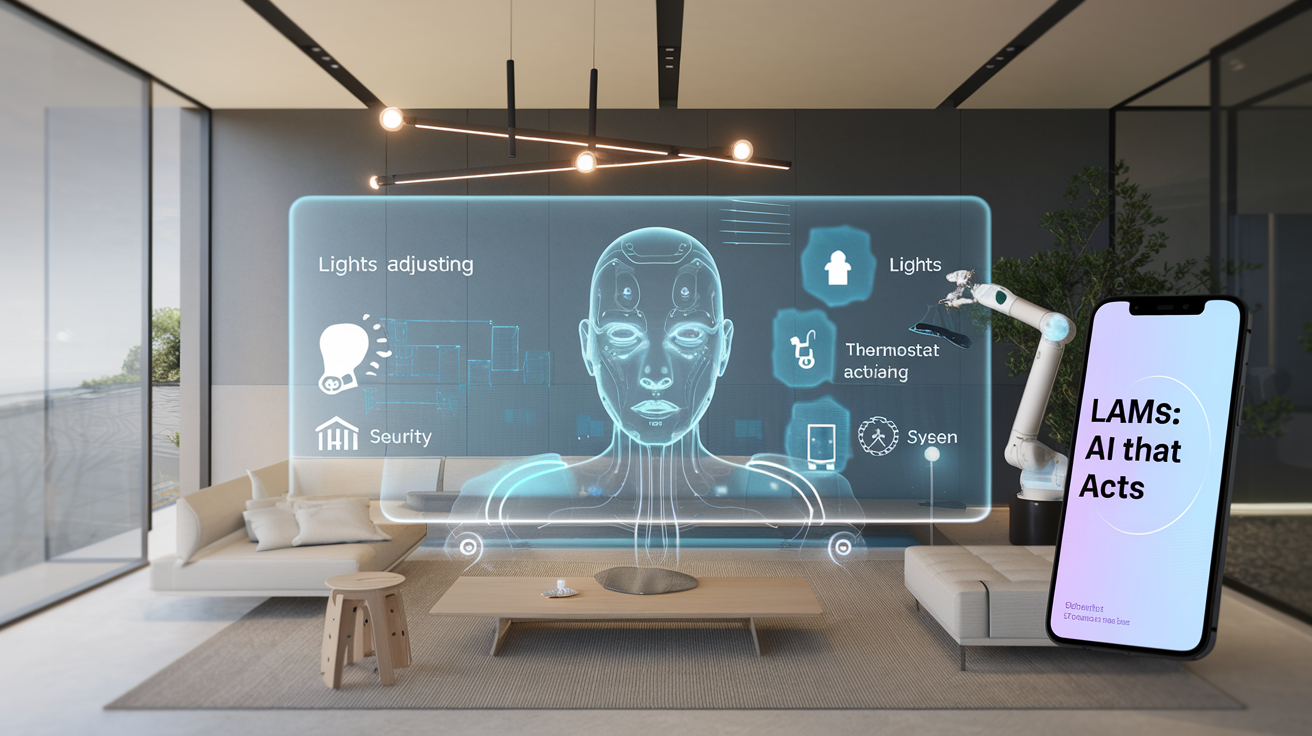Ever asked Alexa to turn on your lights only to get a Wikipedia definition of electricity instead? Frustrating, right?
That’s the problem with most AI today—all talk, no action. But what if your AI assistant could actually DO things for you without constant hand-holding?
Enter Language Action Models (LAMs), the breakthrough in AI that doesn’t just understand your requests but executes them. These new systems are redefining what’s possible with artificial intelligence by connecting directly to your apps and services.
You’re probably thinking, “Haven’t heard this promise before?” Sure, but here’s where it gets interesting: LAMs don’t need special programming for each task. They learn to interact with software almost like humans do.
So why does this matter for your daily life? Well, that’s where things get really exciting…
What are LAMs: Understanding the Next Evolution in AI

Defining Language Action Models (LAMs)
Ever seen those sci-fi movies where AI doesn’t just chat but actually does stuff? That’s basically what LAMs are shooting for. Language Action Models take AI beyond just clever conversation into the realm of getting things done.
Unlike chatbots that only talk, LAMs can interact with software, control systems, and make decisions based on what you ask them. They’re built to bridge the gap between understanding what you want and making it happen in the real world.
Think of LAMs as AI with hands. They can book your flights, schedule appointments, or order groceries without you having to lift a finger beyond the initial request.
How LAMs differ from traditional Large Language Models
Traditional LLMs like ChatGPT are basically super-powered text predictors. You ask something, they respond with words. That’s it.
LAMs take a massive leap forward:
| Traditional LLMs | Language Action Models |
|---|---|
| Generate text responses | Execute real-world actions |
| Passive information providers | Active task performers |
| Confined to language domain | Interface with external systems |
| Need humans to implement suggestions | Can implement solutions directly |
The difference? LAMs don’t just tell you how to solve a problem—they solve it for you.
The key innovation: Bridging language understanding and real-world actions
The magic of LAMs lives in their ability to translate human instructions into actual computer operations.
These systems contain two crucial parts:
- A powerful language understanding component that gets what you’re asking for
- An action framework that connects to APIs, software, and digital services
This combo means when you say “Book me a table at that Italian place for Friday,” the AI doesn’t just understand your request—it can actually make the reservation.
What makes this breakthrough possible is how LAMs map natural language to specific executable functions. They’ve been trained to recognize when words should trigger actions, not just generate more words.
Why LAMs represent a paradigm shift in artificial intelligence
This isn’t just an upgrade—it’s a fundamental reimagining of what AI can be.
For decades, we’ve been building AIs that think. Now we’re building AIs that do. The shift from passive knowledge repositories to active agents changes everything.
With LAMs, AI moves from being a tool you must operate to an assistant that operates on your behalf. This breaks down the barriers between human intent and digital execution.
The real game-changer? LAMs can chain multiple actions together to complete complex tasks. They can reason about the results of one action before determining the next—just like humans do.
We’re witnessing the birth of truly autonomous AI systems that don’t just understand the world but can actually participate in it.
The Technical Breakthrough Behind LAMs

The Architecture That Powers Action-Capable AI
Ever wondered what makes LAMs different from the chatbots you’re used to? It’s all in the architecture. While traditional language models are built to predict the next word in a sequence, LAMs are architected with action execution pathways built right in.
Think of it this way: a regular AI is like someone who can describe how to ride a bike in perfect detail but has never actually touched one. LAMs, on the other hand, can grab the handlebars and start pedaling.
The secret sauce? LAMs use a multi-modal architecture that processes both language and action representations simultaneously. They have dedicated neural pathways for understanding commands, planning sequences of actions, and interfacing with external systems—be it APIs, robotic controls, or software functions.
How LAMs Process Commands and Convert Them to Actions
Here’s where things get interesting. When you ask a LAM to do something, it doesn’t just generate text about doing it—it triggers an action pipeline:
- It interprets your request through natural language understanding
- Maps that understanding to its library of possible actions
- Plans the execution sequence, considering dependencies and constraints
- Sends structured commands to the appropriate systems
- Monitors the results and adjusts as needed
The magic happens in the bridge between language representation and action execution. LAMs maintain a constantly updated internal state that tracks both conversation and action history, creating a coherent experience.
The Role of Training Data in Teaching AI to Act, Not Just Respond
You can’t learn to swim by reading books about swimming. Similarly, LAMs need special training data that goes beyond text.
The training corpus for LAMs includes:
- Demonstrations of actions performed by humans
- Paired command-action sequences
- Success and failure examples with feedback
- Multi-turn interactions showing how actions build on each other
This isn’t just about more data—it’s about fundamentally different data. Developers are creating massive datasets of action-oriented examples, often through reinforcement learning from human feedback where the AI is rewarded for successfully completing tasks, not just sounding smart.
Real-World Applications of LAMs Today

Home automation and IoT integration
Remember when we had to actually flip light switches? Those days are fading fast. LAMs are transforming our homes into responsive environments that don’t just listen but actually do things. Unlike traditional voice assistants that merely turn on your lights, LAMs can notice you’re watching a movie, dim the lights, adjust the temperature, and order your favorite pizza—all without explicit commands.
A homeowner in Seattle reported: “My LAM-powered system noticed I was working late, kept my office lights on, and even rescheduled my smart thermostat so I wouldn’t freeze.”
Business process automation without human intervention
LAMs are crushing it in business settings. They’re not just chatbots answering questions—they’re taking real action that used to require human hands on keyboards.
In finance, LAMs are processing loan applications from start to finish, making decisions, generating documents, and even communicating with applicants. No human required until the complex edge cases.
One bank slashed processing time from 3 days to 17 minutes using Large Action Models that coordinate across multiple systems.
Healthcare applications: From diagnosis to treatment coordination
Healthcare is where action-oriented artificial intelligence truly shines. LAMs don’t just suggest diagnoses—they coordinate entire care workflows.
They’re scheduling follow-ups, ordering tests, and ensuring patients follow treatment plans. One hospital network reported 38% improvement in patient compliance after implementing LAM technology that sends personalized reminders and adjusts care plans based on patient responses.
Customer service revolution: Beyond chatbots to solution providers
Sick of chatbots that can’t actually solve your problem? LAMs change the game completely.
When you contact customer service powered by LAMs, you’re talking to a system that can:
- Access your account
- Process refunds immediately
- Schedule technicians
- Modify orders
- Negotiate solutions within company guidelines
Entertainment and gaming: Creating responsive, adaptive experiences
Gaming with LAMs is mind-blowing. These systems create truly adaptive experiences that respond to your play style, emotions, and preferences.
One gaming studio implemented LAMs to generate completely unique storylines for each player. The NPCs don’t just follow scripts—they develop relationships with players, remember past interactions, and create custom challenges based on player skill levels.
Game environments evolve naturally based on collective player actions, creating constantly fresh experiences without developer intervention.
The Benefits of Action-Oriented AI

Time savings through automated task completion
Picture this: You’re juggling eight different apps just to book a vacation. LAMs change that game completely. While traditional AI might suggest flights or hotels, LAMs actually book them for you—comparing options, checking your calendar, and finalizing reservations without you lifting a finger.
The time savings are massive. What used to take you 45 minutes of app-switching and form-filling now happens automatically while you focus on work that matters. LAMs don’t just understand commands—they execute them across multiple systems.
Reduced friction between digital commands and physical results
The gap between saying “I want this” and actually getting it done is what I call the “intention gap.” LAMs bridge this perfectly.
When you tell a normal AI “Order my usual coffee,” it might just remind you of your preference. But action-oriented AI will place the order, pay for it, and time the pickup perfectly for your morning commute.
This isn’t just convenience—it’s removing the cognitive load of translating thoughts into digital actions.
New accessibility options for those with disabilities
For people with disabilities, LAMs are game-changers. Someone with limited mobility can now say “prepare for my meeting” and have their action AI send documents, set up video calls, and adjust smart home settings.
The independence LAMs provide isn’t incremental—it’s transformative. People who previously needed assistance for digital tasks can now accomplish complex sequences through simple voice commands.
Economic impact and productivity gains
The numbers here are staggering. Early adopters report productivity jumps of 23-38% when implementing LAMs for routine tasks.
Think about all those micro-decisions eating your day:
- Scheduling follow-ups
- Formatting documents
- Researching options
- Coordinating between tools
When LAMs handle these, knowledge workers can redirect hours daily toward creative and strategic work—the stuff automation can’t touch. This isn’t just saving time; it’s fundamentally upgrading human capability.
Ethical Considerations and Challenges

A. Security concerns when AI can take actions
Think about this: LAMs don’t just chat—they can control software, interact with APIs, and manipulate real-world systems. Pretty powerful stuff, right? But with that power comes serious security risks.
When an AI can actually do things in the world, the stakes skyrocket. A compromised LAM could potentially:
- Access sensitive data systems
- Manipulate financial transactions
- Control critical infrastructure
- Execute harmful commands without human verification
Unlike traditional models that just generate text, LAMs blur the line between digital and physical worlds. A security breach isn’t just about data leakage anymore—it’s about what actions the AI might take.
B. Permission models and consent frameworks
So how do we keep LAMs in check? Through robust permission systems that work kinda like your phone asking before an app accesses your camera.
Smart consent frameworks for LAMs need to:
- Require explicit authorization for high-risk actions
- Implement time-limited permissions that expire
- Include human verification loops for critical operations
- Maintain detailed audit trails of all actions taken
The industry’s still figuring this out, but the consent model will likely need to be way more sophisticated than the simple “I agree” buttons we mindlessly click today.
C. Liability issues: Who’s responsible when LAMs make mistakes?
When your LAM-powered assistant accidentally orders 50 pizzas instead of 5, who pays the bill?
This question gets messy fast. Is it:
- The developer who built the model?
- The company that deployed it?
- The user who initiated the interaction?
- The AI itself? (Spoiler: our legal systems aren’t ready for that)
We’re entering uncharted territory where traditional liability frameworks don’t quite fit. Insurance companies are already scrambling to develop new policies for AI action risks.
D. Preventing misuse while encouraging innovation
The balancing act is tricky—we want LAMs to revolutionize how we interact with technology without creating new avenues for harm.
Some promising approaches include:
- Creating industry-wide safety standards specific to action-taking AI
- Implementing graduated access levels based on proven safety records
- Developing open-source tools for LAM safety testing
- Establishing regulatory sandboxes where companies can experiment under supervision
The goal isn’t to slam the brakes on LAMs development but to ensure it happens responsibly. And honestly, that’s the only way this technology will reach its full potential.
Getting Started with LAMs

Available platforms and technologies
Want to jump into the LAMs revolution? You’ve got options. Major AI companies like OpenAI, Anthropic, and Google are already building Large Action Models that connect directly with real-world systems.
Right now, you can check out:
- Adept’s ACT-1: Takes real actions on your computer
- Google’s Project Astra: Interacts with web browsers and applications
- OpenAI’s GPT-4o with vision: Can analyze images and suggest actions
The tech stack typically includes:
- Foundation models similar to LLMs but trained on action sequences
- API connectors to various external systems
- Safety guardrails (super important with action-taking AI)
Integration options for developers
If you’re a developer itching to build with LAMs, the landscape is looking pretty sweet.
Most LAMs offer REST APIs that let you integrate these systems with just a few lines of code. The real magic happens when you connect them to:
- Customer service platforms
- Smart home ecosystems
- Business automation software
- E-commerce systems
Some platforms provide SDKs in Python, JavaScript, and other languages, making integration even smoother. Many come with pre-built connectors for popular services like Zapier, IFTTT, or Slack.
User-friendly interfaces for non-technical users
Not a coder? No problem.
Many LAM platforms now offer no-code interfaces where you can:
- Create action sequences through visual builders
- Set up trigger conditions with simple dropdown menus
- Test actions in sandbox environments before going live
Think of it like creating a recipe: “When this happens, do this, then this.”
Cost considerations and ROI potential
LAMs aren’t cheap—but they might be worth every penny.
Initial pricing models vary widely:
- Subscription-based access ($100-1000/month)
- Pay-per-action models (typically $0.01-0.10 per action)
- Enterprise plans with custom pricing
The ROI can be substantial though. Companies report:
- 70% reduction in customer service handling time
- 40-60% decrease in process completion times
- 3-5x faster execution of repetitive tasks
The key is starting small—automate one workflow, measure the results, then expand.

The emergence of LAMs (Language-Action Models) represents a significant paradigm shift in artificial intelligence. Beyond the text-generating capabilities of traditional language models, LAMs bridge the gap between understanding and action, enabling AI systems to interact with digital tools, make decisions, and execute real-world tasks with greater autonomy and effectiveness. As we’ve explored, these developments bring tremendous benefits across industries while introducing important ethical considerations that must be addressed thoughtfully.
Whether you’re a developer eager to experiment with this technology, a business leader looking to implement AI solutions, or simply curious about the future of intelligent systems, LAMs offer an exciting glimpse into a world where AI becomes a more capable partner in our daily lives. The time to engage with this technology is now—start small, focus on specific use cases, and join the community of innovators shaping how AI will not just communicate, but meaningfully act in our increasingly digital world.




















